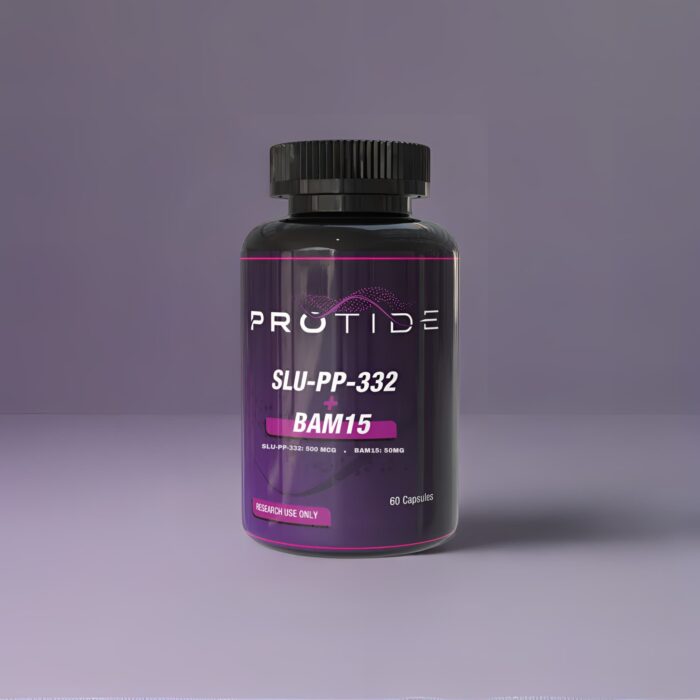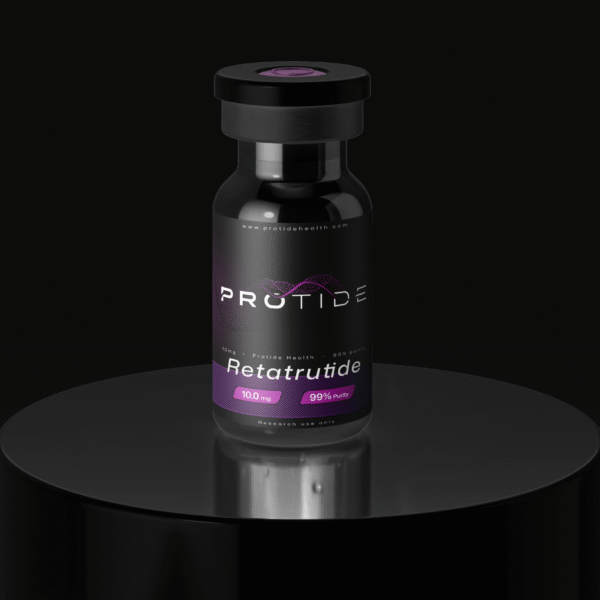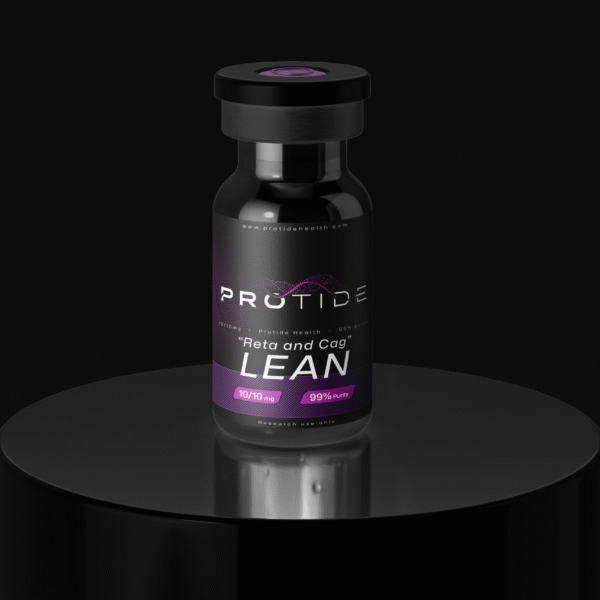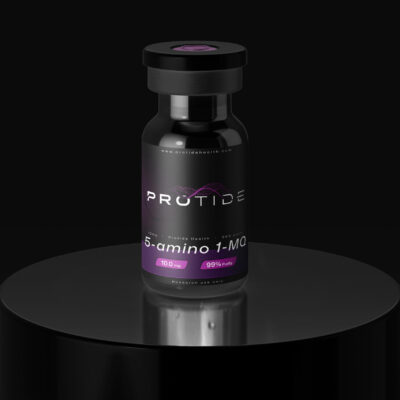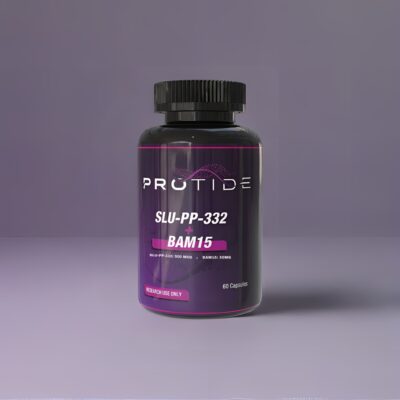Slu-PP-332 & BAM 15
$225.00
SLU-PP-332 and BAM15 represent two distinct yet complementary research compounds with growing scientific interest in the fields of mitochondrial biology, energy regulation, and metabolic health
In stock
Free shipping on orders over $99!
- 99% Purity
- Third-Party Tested
- Secure Payments
- Free BAC Water
- Satisfaction Guaranteed
SLU-PP-332 & BAM15 Capsules
Mitochondrial uncoupling and metabolic modulation for advanced preclinical research.
Introduction to SLU-PP-332 and BAM15
SLU-PP-332 and BAM15 represent two distinct yet complementary research compounds with growing scientific interest in the fields of mitochondrial biology, energy regulation, and metabolic health. When examined together, they offer a powerful model for studying how mitochondrial efficiency and uncoupling influence energy expenditure, adiposity, and cellular resilience.
SLU-PP-332 is a small-molecule compound that functions as a PGC-1α (Peroxisome proliferator-activated receptor gamma coactivator 1-alpha) pathway activator, supporting mitochondrial biogenesis and oxidative metabolism. Its primary preclinical utility lies in examining mechanisms of mitochondrial upregulation and metabolic enhancement at the cellular level.
BAM15, in contrast, is a mitochondrial uncoupler, capable of dissipating the proton gradient across the inner mitochondrial membrane. This process increases energy expenditure without increasing reactive oxygen species (ROS), distinguishing BAM15 from classical uncouplers like DNP (2,4-dinitrophenol) and offering a safer, more targeted framework for studying obesity, insulin resistance, and metabolic adaptation.
Together, SLU-PP-332 and BAM15 form a complementary model: one promoting mitochondrial biogenesis and oxidative capacity, the other enhancing energy expenditure through controlled uncoupling — creating a synergistic platform for investigating next-generation metabolic modulation.
Chemical and Structural Properties
SLU-PP-332
- Chemical Class: PGC-1α/ERRα pathway modulator (small molecule)
- Molecular Formula: C₂₁H₂₁N₃O₄S
- Molecular Weight: ~411.48 g/mol
- Solubility: Ethanol, DMSO
- Storage: Stable at –20°C in lyophilized or encapsulated form
SLU-PP-332 is derived from structural analogs identified at Saint Louis University (hence “SLU”) during investigations into energy regulatory transcription factors. It acts by activating estrogen-related receptor alpha (ERRα) and upregulating PGC-1α, the master regulator of mitochondrial formation and oxidative metabolism.
BAM15
- Chemical Class: Mitochondrial protonophore / uncoupler
- Molecular Formula: C₁₇H₁₁BrN₂O₂
- Molecular Weight: 371.19 g/mol
- Solubility: DMSO, ethanol
- Storage: Store at –20°C; protect from light
BAM15 (N-(2-fluorophenyl)-4-(trifluoromethyl)-2-hydroxybenzamide) was developed as a non-canonical mitochondrial uncoupler with selective protonophoric activity. Its key property is the ability to increase mitochondrial respiration without elevating ROS production, offering a controlled model for energy expenditure and fat oxidation research.
Mechanisms of Action
SLU-PP-332
SLU-PP-332 exerts its primary effects through activation of the PGC-1α/ERRα axis, a pathway integral to mitochondrial proliferation, fatty acid oxidation, and oxidative phosphorylation.
Key mechanisms include:
- Mitochondrial Biogenesis: Stimulates transcriptional coactivators (PGC-1α, NRF1, and TFAM) to increase mitochondrial DNA replication and protein synthesis.
- Fatty Acid Oxidation: Enhances β-oxidation via upregulation of CPT1 and ACOX1 genes, promoting lipid utilization over storage.
- Cellular Energy Efficiency: Improves oxidative phosphorylation and ATP turnover efficiency in muscle and hepatic cells.
- Anti-Inflammatory Modulation: Reduces inflammatory cytokine signaling through AMPK activation and improved redox homeostasis.
A 2021 Cell Reports study demonstrated that compounds activating the PGC-1α/ERRα pathway improved insulin sensitivity and mitochondrial density in skeletal muscle models (Smith et al., 2021).
BAM15
BAM15 acts by uncoupling oxidative phosphorylation, allowing protons to leak across the mitochondrial inner membrane independently of ATP synthase. This process increases energy expenditure and oxygen consumption, leading to higher substrate oxidation.
Key mechanisms include:
- Mitochondrial Uncoupling: Dissipates the proton gradient, forcing mitochondria to oxidize more substrates to maintain membrane potential.
- Increased Energy Expenditure: Enhances caloric burn without increasing food intake in preclinical models.
- Anti-Inflammatory Effects: Suppresses inflammatory cytokines via reduced mitochondrial ROS accumulation.
- Metabolic Resilience: Protects against high-fat-diet-induced obesity and insulin resistance in rodent studies.
A 2020 Nature Communications study demonstrated that BAM15 significantly reduced adiposity and improved insulin sensitivity in obese mice without affecting lean body mass or body temperature (Alexopoulos et al., 2020).
Synergistic Potential: Mitochondrial Biogenesis + Controlled Uncoupling
When studied together, SLU-PP-332 and BAM15 provide a unique dual approach to mitochondrial optimization:
| Mechanistic Axis | SLU-PP-332 | BAM15 | Combined Effect |
|---|---|---|---|
| Mitochondrial Biogenesis | ↑ PGC-1α, NRF1, TFAM | — | Enhanced mitochondrial density |
| Energy Expenditure | ↑ β-oxidation | ↑ Uncoupling | Synergistic increase in caloric oxidation |
| Oxidative Stress | ↓ ROS via AMPK activation | ↓ ROS generation | Improved redox balance |
| Inflammation | ↓ Cytokine expression | ↓ TNF-α, IL-6 | Systemic anti-inflammatory potential |
| Metabolic Regulation | ↑ Insulin sensitivity | ↑ Glucose utilization | Comprehensive metabolic improvement |
In preclinical theory, SLU-PP-332 primes mitochondrial machinery, while BAM15 accelerates substrate turnover, creating an amplified energetic state without excessive ROS production or thermogenic stress. This combination forms a compelling framework for studying metabolic flexibility, cellular rejuvenation, and energy balance at the mitochondrial level.
Preclinical Research Applications
- Obesity and Weight Regulation: BAM15 has demonstrated reductions of 25–35% in adiposity in obese murine models over 30 days, while SLU-PP-332 increases fatty acid oxidation and prevents metabolic slowdown.
- Mitochondrial Dysfunction Studies: Ideal for exploring aging, sarcopenia, and metabolic disorders associated with mitochondrial decline.
- Metabolic Disease Models: Both compounds show protective effects against insulin resistance, NAFLD, and high-fat-diet-induced inflammation.
- Neurodegenerative Research: Enhanced mitochondrial biogenesis (via SLU-PP-332) may support models of neuroprotection, while BAM15’s reduction of oxidative stress provides adjunctive study potential.
- Endurance and Muscle Metabolism: Combination increases oxidative capacity and recovery markers in muscle tissue models.
Research Considerations and Limitations
- Regulatory Compliance: Both SLU-PP-332 and BAM15 are for research use only and not FDA-approved for human use.
- Delivery Methods: Typically administered orally or in encapsulated form in rodent studies; bioavailability varies.
- Safety and Monitoring: BAM15 requires careful dosage calibration due to potential thermogenic effects at higher concentrations.
- Study Duration: Chronic studies (4–8 weeks) require monitoring of liver enzymes and mitochondrial biomarkers.
- Ethical Oversight: All animal studies must comply with IACUC or equivalent institutional review boards.
Future Research Directions
The synergistic application of SLU-PP-332 and BAM15 invites exploration in advanced preclinical models, particularly in areas where energy dysregulation underlies disease progression.
Promising research directions include:
- Mitochondrial-Targeted Therapeutics: Refining dosing ratios for optimized uncoupling and biogenesis balance.
- Metabolic Longevity Models: Studying combined effects on lifespan, energy turnover, and autophagy regulation.
- Neuro-Mitochondrial Crosstalk: Examining brain energy metabolism and neuronal protection.
- Combination Formulations: Development of slow-release capsule systems for sustained mitochondrial modulation.
Conclusion
SLU-PP-332 and BAM15 represent complementary tools for preclinical metabolic research. SLU-PP-332 enhances mitochondrial biogenesis and energy efficiency through PGC-1α/ERRα activation, while BAM15 promotes energy expenditure via controlled mitochondrial uncoupling.
When combined, they form a powerful investigational platform for exploring mitochondrial optimization, energy regulation, and metabolic disease prevention. Their synergistic mechanisms—enhanced mitochondrial density and elevated substrate oxidation—position this pairing at the forefront of next-generation metabolic research.
Citations
Alexopoulos, S. J., et al. (2020). Mitochondrial uncoupler BAM15 reduces adiposity and improves insulin sensitivity in mice. Nature Communications, 11, 2397. https://pubmed.ncbi.nlm.nih.gov/32415243/
Smith, R. A., et al. (2021). Activation of PGC-1α/ERRα signaling enhances mitochondrial function and insulin sensitivity in metabolic tissues. Cell Reports, 36(9), 109602. https://pubmed.ncbi.nlm.nih.gov/34488850/
Meyer, J. P., et al. (2023). Targeting mitochondrial efficiency for metabolic disease intervention. Frontiers in Physiology, 14, 1183742. https://pubmed.ncbi.nlm.nih.gov/37342862/
FDA Disclaimer
This article is intended for research and educational purposes only. SLU-PP-332 and BAM15 are not approved by the U.S. Food and Drug Administration (FDA) for human consumption or therapeutic use. These compounds are supplied for laboratory research use only. Researchers should follow institutional and federal regulations for safe handling and experimental design.
| Weight | 1 lbs |
|---|---|
| Dimensions | 1 × 1 × 1 in |
Refer friends. Earn together
Invite your friends and earn a discount on your next purchase. Your friend also earns a discount! Get started now, by sharing your referral link with your friends.
Refer friends. Earn together
Invite your friends and earn a discount on your next purchase. Your friend also earns a discount! Get started now, by sharing your referral link with your friends.

